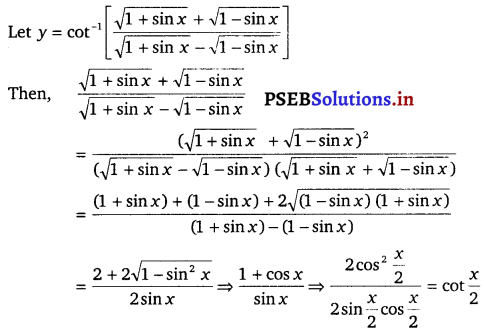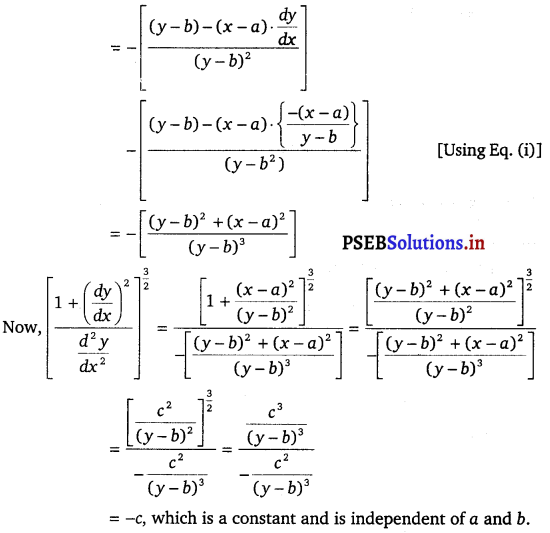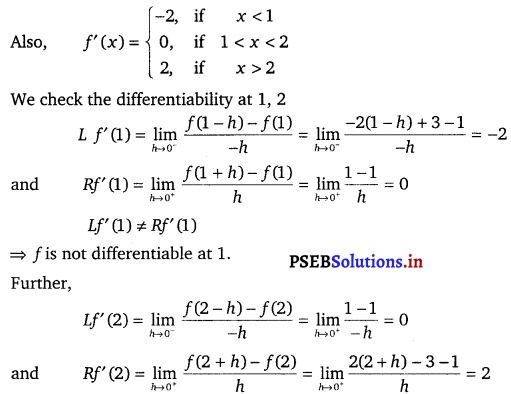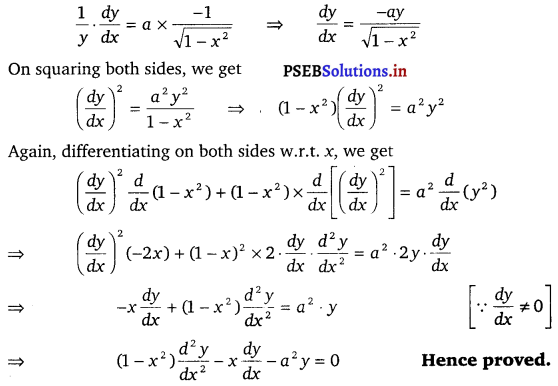Punjab State Board PSEB 12th Class Maths Book Solutions Chapter 5 Continuity and Differentiability Miscellaneous Exercise Questions and Answers.
PSEB Solutions for Class 12 Maths Chapter 5 Continuity and Differentiability Miscellaneous Exercise
Direction (1 – 11) :
Differentiate the following functions with respect to x.
Question 1.
(3x2 – 9x + 5)9
Solution.
Let y = (3x2 – 9x + 5)9
Differentiating w.r.t. x, we get
\(\frac{d y}{d x}\) = \(\frac{d}{d x}\) (3x2 – 9x + 5)9
= 9(3x2 – 9x + 5)8 – (3x2 – 9x + 5) dx
= 9(3x2 – 9x + 5)8 . 8 (6x – 9)
= 9(3x2 – 9x + 5)8 . 3(2x – 3)
= 27(3x2 – 9x + 5)8 (2x – 3)
Question 2.
sin3 x + cos6 x
Solution.
Let y = sin3 x + cos6 x
Differentiating w.r.t. x, we get
\(\frac{d y}{d x}\) = \(\frac{d}{d x}\) (sin3 x) + \(\frac{d}{d x}\) (cos6 x)
= 3 sin2 x \(\frac{d}{d x}\) (sin x) + 6 cos5 x . \(\frac{d}{d x}\) (cos x)
= 3 sin2 x cos x + 6 cos5 x . (- sin x)
= 3 sin x cos x (sin x – 2 cos4 x).
![]()
Question 3.
(5x)3 cos 2x
Solution.
Let y = (5x)3 cos 2x
Taking logarithm on both sides, we get
log y = 3 cos 2x log 5x
Differentiating on both sides w.r.t. x, we get
\(\frac{1}{y}\) \(\frac{d y}{d x}\) = 3 [log 5x . \(\frac{d}{d x}\) (cos 2x) + cos 2x . \(\frac{d}{d x}\) (log 5x)]
⇒ \(\frac{d y}{d x}\) = 3y [log 5x (- sin 2x) . \(\frac{d}{d x}\) (2x) + cos 2x . \(\frac{1}{5 x}\) . \(\frac{d}{d x}\) (5x)]
⇒ \(\frac{d y}{d x}\) = 3y [- 2 sin 2x log 5x + \(\frac{\cos 2 x}{x}\)]
⇒ \(\frac{d y}{d x}\) = y [\(\frac{3 \cos 2 x}{x}\) – 6 sin 2x log 5x]
∴ \(\frac{d y}{d x}\) = (5x)3 cos 2x [\(\frac{3 \cos 2 x}{x}\) – 6 sin 2x log 5x]
Question 4.
sin-1(x√x), 0 ≤ x ≤ 1
Solution.
Let y = sin-1 (x√x)
Differentiating w.r.t. x, we get
\(\frac{d y}{d x}\) = \(\frac{d}{d x}\) sin-1 (x√x)
= \(\frac{1}{\sqrt{1-(x \sqrt{x})^{2}}} \times \frac{d}{d x}(x \sqrt{x})\)
= \(\frac{1}{\sqrt{1-x^{3}}} \cdot \frac{d}{d x}\left(x^{\frac{3}{2}}\right)\)
= \(\frac{1}{\sqrt{1-x^{3}}} \times \frac{3}{2} \cdot x^{\frac{1}{2}}\)
= \(\frac{3 \sqrt{x}}{2 \sqrt{1-x^{3}}} \Rightarrow \frac{3}{2} \sqrt{\frac{x}{1-x^{3}}}\)
![]()
Question 5.
\(\frac{\cos ^{-1} \frac{x}{2}}{\sqrt{2 x+7}}\), – 2 < x < 2
Solution.
Let y = \(\frac{\cos ^{-1} \frac{x}{2}}{\sqrt{2 x+7}}\)
Differentiating w.r.t. x, we get

Question 6.
cot-1 \(\left[\frac{\sqrt{1+\sin x}+\sqrt{1-\sin x}}{\sqrt{1+\sin x}-\sqrt{1-\sin x}}\right]\), 0 < x < \(\frac{\pi}{2}\)
Solution.

Therefore, Eq. (i) becomes
y = cot-1 (cot \(\frac{x}{2}\))
⇒ y = \(\frac{x}{2}\)
Differentiating w.r.t. x, we get
\(\frac{d y}{d x}\) = \(\frac{1}{2}\) \(\frac{d}{d x}\) (x)
⇒ \(\frac{d y}{d x}\) = \(\frac{1}{2}\).
![]()
Question 7.
(log x)log x, x > 1
Solution.
Let y = (log x)log x
Taking logarithm on both sides, we get
log y = log (log x)log x
⇒ log y = log x . log(log x)
Differentiating both sides w.r.t. x, we get
\(\frac{1}{y}\) . \(\frac{d y}{d x}\) = \(\frac{d}{d x}\) [log x . log(log x)] y
⇒ \(\frac{1}{y}\) . \(\frac{d y}{d x}\) = log (log x) . \(\frac{d}{d x}\) (log x) + log x . \(\frac{d}{d x}\) [log (log x)]
⇒ \(\frac{d y}{d x}\) = y [log (log x) . \(\frac{1}{x}\) + log x . \(\frac{1}{\log x}\) . \(\frac{d}{d x}\) (log x)]
⇒ \(\frac{d y}{d x}\) = y [\(\frac{1}{x}\) log (log x) + \(\frac{1}{x}\)]
∴ \(\frac{d y}{d x}\) = (log x)log x [\(\frac{1}{x}\) log (log x) + \(\frac{1}{x}\)]
Question 8.
cos(a cos x + b sin x), for some constant a and b.
Solution.
Let y = cos(acosx + bsinx)
Differentiating w.r.t. x, we get
\(\frac{d y}{d x}\) = \(\frac{d}{d x}\) cos(a cos x + b sin x)
\(\frac{d y}{d x}\) = – sin(a cos x + b sin x) . \(\frac{d}{d x}\) (a cos x + b sin x)
= – sin(a cos x + b sin x) . [a (- sin x) + b cos x]
= (a sin x – b cos x) . sin (a cos x + b sin x).
![]()
Question 9.
(sin x – cos x)(sin x – cos x), \(\frac{\pi}{4}<x<\frac{3 \pi}{4}\)
Solution.
Let y = (sin x – cos x) (sin x – cos x)
Taking logarithm on both sides, we get
log y = log (sin x – cos x)[(sin x – cos x)(sin x – cos x)]
⇒ log y = (sin x – cos x) . log(sin x – cos x)
Differentiating on both sides w.r.t. x, we get
\(\frac{1}{y}\) . \(\frac{d y}{d x}\) = \(\frac{d}{d x}\) [(sin x – cos x) log(sin x – cos x)]
⇒ \(\frac{1}{y}\) . \(\frac{d y}{d x}\) = log (sin x – cos x) . \(\frac{d}{d x}\) log (sin x – cos x) – (sin x – cos x) + (sin x – cos x) . \(\frac{d}{d x}\) log (sin x – cos x)
⇒ \(\frac{d y}{d x}\) = (sin x – cos x)(sin x – cos x) [(cos x + sin x) . log (sin x – cos x) + (cos x – sin x)]
∴ \(\frac{d y}{d x}\) = (sin x – cos x)(sin x – cos x) (cos x + sin x) [1 + log (sin x – cos x)]
Question 10.
xx + xa + ax + aa, for some fixed a > 0 and x > 0.
Solution.
Let y = xx + xa + ax + aa
Also, let xx = u, xa = v, ax = w, and aa = s
∴ y = u + v + w + s
Differentiating w.r.t. x, we get
\(\frac{d y}{d x}=\frac{d u}{d x}+\frac{d v}{d x}+\frac{d w}{d x}+\frac{d s}{d x}\) ……………(i)
Then, u = xx
⇒ log u = log xx (Taking log on both sides)
⇒ log u = x logx
Differentiating on both sides w.r.t. x, we get
\(\frac{1}{u}\) \(\frac{d u}{d x}\) = log x . \(\frac{d}{d x}\) (x) + x . \(\frac{d}{d x}\) (log x)
⇒ \(\frac{d u}{d x}\) = u [log x . 1 + x . \(\frac{1}{x}\)]
⇒ \(\frac{d u}{d x}\) = xx [log x + 1]
= xx (1 + log x) …………..(ii)
v = xa
Differentiating w.r.t. x, we get
\(\frac{d v}{d x}\) = \(\frac{d}{d x}\) (xa)
⇒ \(\frac{d v}{d x}\) = a xa – 1 ………….(iii)
w = ax
⇒ log w = log ax
⇒ log w = a log x
Differentiating on both sides w.r.t. x, we get
⇒ \(\frac{d w}{d x}\) = log a . \(\frac{d}{d x}\) (x)
⇒ \(\frac{d w}{d x}\) = ax log a ………………(iv)
s = aa
Since, a is constant, therefore aa is also a constant.
∴ \(\frac{d s}{d x}\) = 0 …………..(v)
From Eqs. (i), (ii), (iii), (iv) and (v), we get
\(\frac{d y}{d x}\) = xx (1 + log x) + a xa – 1 + ax log a + 0
= xxx (1 + log x) + a xa – 1 + ax log a.
![]()
Question 11.
xx2 – 3 + (x – 3)x2, for x > 3.
Solution.
Let y = xx2 – 3 + (x – 3)x2
Also, let u = xx2 – 3 and v = (x – 3)x2
∴ y = u + v
Differentiating w.r.t. x, we get
\(\frac{d y}{d x}=\frac{d u}{d x}+\frac{d v}{d x}\)
Then, u = xx2 – 3
Taking log on both sides, we get
log u = log xx2 – 3
= (x2 – 3) log x
Differentiating w.r.t. x, we get
\(\frac{1}{u}\) \(\frac{d u}{d x}\) = 2x log x + (x2 – 3) log x × \(\frac{1}{x}\)
∴ \(\frac{d u}{d x}\) = u (2x log x + \(\frac{x^{2}-3}{x}\))
= xx2 – 3 (2x log x + \(\frac{x^{2}-3}{x}\)) …………….(ii)
Also, v = (x – 3)x2
Differentiating on both sides, we get
\(\frac{1}{v}\) \(\frac{d v}{d x}\) = \(\frac{d v}{d x}\) [2x log (x – 3) + \(\frac{x^{2}-3}{x}\)] ……………..(iii)
From Eqs. (i), (ii) and (iii), we get
\(\frac{d y}{d x}\) = xx2 – 3 \(\left(2 x \log x+\frac{x^{2}-3}{x}\right)+(x-3)^{x^{2}}\left[2 x \log (x-3)+\frac{x^{2}}{x-3}\right]\)
Question 12.
Find \(\frac{d y}{d x}\), if y = 12 (1 – cos t), x = 10 (t – sin t), \(-\frac{\pi}{2}<t<\frac{\pi}{2}\)
Solution.
Given, y = 12 (1 – cos t) and x = 10 (t – sin t)
Differentiating w.r.t t, we get
\(\frac{d x}{d t}\) = \(\frac{d}{d t}\) [10 (t – sin t)]
= 10 . \(\frac{d}{d t}\) (t – sin t)
= 10 (1 – cos t)
and \(\frac{d y}{d t}\) = \(\frac{d}{d t}\) [12 (1 – cos t)]
= 12 . \(\frac{d}{d t}\) (1 – cos t)
= 12 . [0 – (- sin t)] = 12 sin t
Now, \(\frac{d y}{d x}\) = \(\frac{\left(\frac{d y}{d t}\right)}{\left(\frac{d x}{d t}\right)}=\frac{12 \sin t}{10(1-\cos t)}\)
= \(\frac{12 \cdot 2 \sin \frac{t}{2} \cdot \cos \frac{t}{2}}{10 \cdot 2 \sin ^{2} \frac{t}{2}}=\frac{6}{5} \cot \frac{t}{2}\).
![]()
Question 13.
Find \(\frac{d y}{d x}\), if y = sin-1 x + sin-1 \(\sqrt{1-x^{2}}\), – 1 ≤ x ≤ 1.
Solution.
Given, y = sin-1 x + sin-1 \(\sqrt{1-x^{2}}\)
putting x = sin θ in above eq., we get
y = sin-1 sin θ + sin-1 \(\sqrt{1-(\sin \theta)^{2}}\)
y = θ + sin-1 \(\sqrt{1-(\sin \theta)^{2}}\)
= θ + sin-1 (cos θ)
= θ + sin-1 sin (\(\frac{\pi}{2}\) – θ)
= θ + \(\frac{\pi}{2}\) – θ
Differentiating w.r.t x, we get
∴ \(\frac{d y}{d x}\) = 0
Question 14.
If x \(\sqrt{1+y}\) + y \(\sqrt{1+x}\) = 0, for – 1 < x < 1, prove that \(\frac{d y}{d x}=\frac{1}{(1+x)^{2}}\).
Solution.
Given, x \(\sqrt{1+y}\) + y \(\sqrt{1+x}\) = 0
⇒ x \(\sqrt{1+y}\) = – y \(\sqrt{1+x}\)
On squaring bothsides, we get
x2 (1 + y) = y2 (1 + x)
⇒ x2 + x2y = y2 + xy2
⇒ x2 – y2 = xy2 – x2y
⇒ x2 – y2 = xy (y – x)
⇒ (x + y) (x – y) = xy (y – x)
∴ x + y = -xy
⇒ (1 + x) y = – x
⇒ y = \(\frac{-x}{(1+x)}\)
Differentiating on bothsides w.r.t x, we get
\(\frac{d y}{d x}\) = \(\frac{(1+x) \frac{d}{d x}(x)-x \frac{d}{d x}(1+x)}{(1+x)^{2}}\)
= \(-\frac{(1+x)-x}{(1+x)^{2}}=-\frac{1}{(1+x)^{2}}\)
Hence proved.
![]()
Question 15.
If (x – a)2 + (y – b)2 = c2, for some c > 0, prove that \(\frac{\left(1+\left(\begin{array}{l}
d y \\
d x
\end{array}\right)^{2}\right]^{3}}{d^{2} y} \frac{d x^{2}}{}\) is a constant independent of a and b.
Solution.
Given, (x – a)2 + (y – b)2 = c2
Differentiating on both sides w.r.t. x. we get
\(\frac{d}{d x}\) [(x – a)2] + \(\frac{d}{d x}\) [(y – b)2] = \(\frac{d}{d x}\) (c2)
⇒ 2 (x – a) . \(\frac{d}{d x}\) (x – a) + 2 (y – b) . \(\frac{d}{d x}\) (y – b) = 0
⇒ 2 (x – a) . 1 + 2(y – b) . \(\frac{d y}{d x}\) = 0
⇒ \(\frac{d y}{d x}\) = \(\frac{-(x-a)}{y-b}\) ………………(i)
Again, differentiating w.r.t. x, we get
∴ \(\frac{d^{2} y}{d x^{2}}\) = \(\frac{d}{d x}\left[\frac{-(x-a)}{y-b}\right]\)
= – \(\left[\frac{(y-b) \cdot \frac{d}{d x}(x-a)-(x-a) \cdot \frac{d}{d x}(y-b)}{(y-b)^{2}}\right]\)

Hence proved.
![]()
Question 16.
If cos y = x cos (a + y), with cos a ≠ ± 1, prove that \(\frac{d y}{d x}=\frac{\cos ^{2}(a+y)}{\sin a}\).
Solution.
Given, cos y = x cos(a + y)
Differentiating w.r.t. x, we get
\(\frac{d}{d x}\) [cos y] = \(\frac{d}{d x}\) [x cos (a + y)]
⇒ – sin y = cos (a + y) . \(\frac{d}{d x}\) (x) + x . \(\frac{d}{d x}\) [cos (a + y)]
⇒ – sin y \(\frac{d y}{d x}\) = cos (a + y) + x [- sin (a + y)]
⇒ [x sin (a + y) – sin y] \(\frac{d y}{d x}\) = cos (a + y) ……………(i)
∵ cos y = x cos (a + y), x = \(\frac{\cos y}{\cos (a+y)}\)
Then, Eq. (i) reduces to
[\(\frac{\cos y}{\cos (a+y)}\) . sin (a + y) – sin y] \(\frac{d y}{d x}\) = cos (a + y)
⇒ [cos y . sin (a + y)] – sin y . cos (a + y)] . \(\frac{d y}{d x}\) = cos 2 (a + y)
⇒ sin (a + y – y) \(\frac{d y}{d x}\) = cos2 (a + y)
⇒ \(\frac{d y}{d x}\) = \(\frac{\cos ^{2}(a+y)}{\sin a}\).
Hence proved.
Question 17.
If x = a(cos t + t sin t) and y = a(sin t – t cos t), find \(\frac{d^{2} y}{d x^{2}}\).
Solution.
Given, x = a (cos t + t sin t) and y = a (sin t – t cos t)
Differentiating both Eqs. w.r.t. t, we get
∴ \(\frac{d x}{d t}\) = a \(\frac{d}{d t}\) (cos t + t sin t)
= a [- sin t + sin t . \(\frac{d}{d x}\) (t) + t . \(\frac{d}{d t}\) (sin t)]
= a [- sin t + sin t + t cos t] = at cost
Also, \(\frac{d y}{d t}\) = a \(\frac{d}{d t}\) (sin t – t cost)
= a [cos t – {cos t . \(\frac{d}{d t}\) (t) + t . \(\frac{d}{d t}\) (cost)}]
= a [cos t – {cos t – t sin t}] = at sin t
\(\frac{d y}{d x}\) = \(\frac{\left(\frac{d y}{d t}\right)}{\left(\frac{d x}{d t}\right)}=\frac{a t \sin t}{a t \cos t}\) = tan t
Again, differentiating w.r.t. x, we get
\(\frac{d^{2} y}{d x^{2}}\) = \(\frac{d}{d x}\) (tan t)
= sec2 t . \(\frac{d t}{d x}\)
[∵ \(\frac{d x}{d t}\) = at cos t
⇒ \(\frac{d t}{d x}\) = \(\frac{1}{a t \cos t}\)]
= sec2 t . \(\frac{1}{a t \cos t}\)
= \(\frac{\sec ^{3} t}{a t}\), 0 < t < \(\frac{\pi}{2}\)
![]()
Question 18.
If f(x) = |x|3, show that f”(x) exists for all real x and find it.
Solution.
Here, f(x) = | x |3
When x > 0, f(x) = |x|3 = x3
Differentiating both sides w.r.t. x, we get
\(\frac{d}{d x}\) [f(x)] = \(\frac{d}{d x}\) (x3)
⇒ f'(x) = 3x2
Again, differentiating both sides w.r.t. x, we get
\(\frac{d}{d x}\) [f'(x)] = \(\frac{d}{d x}\) (3x2)
⇒ f”(x) = 6x
When x < 0,
f(x) = |x|3 = – x3
Differentiating both sides w.r.t. x, we get
\(\frac{d}{d x}\) [f(x)] = \(\frac{d}{d x}\) (- x3)
⇒ f'(x) = – 3x2
Again, differentiating both sides w.r.t. x, we get
\(\frac{d}{d x}\) [f'(x)] = \(\frac{d}{d x}\) (- 3x2) = – 6x
f”(x) = – 6x
Hence,f”(x) = 
Question 19.
Using mathematical induction, prove that \(\frac{d}{d x}\) (xn) = n xn – 1 for all positive integers n.
Solution.
Let P(n): \(\frac{d}{d x}\) (xn) = nxn – 1 for all positive integers n
For n = 1,
P(1): \(\frac{d}{d x}\)(x) = 1 = 1 . x1 – 1
∴ P(n) is true for n = 1.
Let P(k) is true for some positive integer k.
i.e., P(k): \(\frac{d}{d x}\) (xk) = k xk – 1
It has to be proved that P(k +1) is also true.
Consider \(\frac{d}{d x}\) (xk – 11) = \(\frac{d}{d x}\) (x . xk)
= xk . \(\frac{d}{d x}\) (x) + x . \(\frac{d}{d x}\) (xk) [Applying product rule]
= (k + 1) . xk
= (k + 1) . x(k+1) – 1
Thus, P(k + 1) is true whenever P(k) is true.
Therefore, by the principle of mathematical induction, the statement P(n) is true for every positive integer n. Hence proved.
![]()
Question 20.
Using the fact that sin (A + B) = sin A cos B + cos A sin B and the differentiation, obtain the sum formula for cosines.
Solution.
We have, sin(A + B) = sin A cos B + cos A sin B
Differentiating on both sides w.r.t. x, we get
⇒ \(\frac{d}{d x}\) [sin(A + B)] = \(\frac{d}{d x}\) (sin A cos B) + \(\frac{d}{d x}\) (cos A sin B)
⇒ cos (A + B) . \(\frac{d}{d x}\) (A + B) = cos B . \(\frac{d}{d x}\) (sin A) + sin A . \(\frac{d}{d x}\) (cos B) + sin B . \(\frac{d}{d x}\) (cos A) + cos A . \(\frac{d}{d x}\) (sin B)
⇒ cos (A + B) . \(\frac{d}{d x}\) (A + B) = cos B cos A \(\frac{d A}{d x}\) + sin A(- sin B) \(\frac{d B}{d x}\) + sin B (- sin A) . \(\frac{d A}{d x}\) + cos A cos B \(\frac{d B}{d x}\)
cos (A + B) = cos A cos B – sin A sin B.
Question 21.
Does there exist a function which is continuous everywhere but not differentiable at exactly two points? Justify your answer.
Solution.
Yes, we have the continuous function f(x) = |x – 1| + |x – 2|, which is continuous at all x ∈ R but differentiable at all x except 1, 2.
Here, f(x) = |x – 1| + |x – 2|
= 
i.e., f(x) = 
Since, polynomial function is continuous, so it is clear that f is continuous at all except possible at 1, 2.
Now, we have to check the continuity at 1, 2
At x = 1 f(1) = 1,
LHL = \(\lim _{x \rightarrow 1^{-}}\) f(x) = \(\lim _{x \rightarrow 1^{-}}\) (- 2x + 3)
= – 2 + 3 = 1
RHL = \(\lim _{x \rightarrow 1^{+}}\) f(x) = \(\lim _{x \rightarrow 1^{+}}\) 1 = 1
⇒ f(1) = \(\lim _{x \rightarrow 1^{-}}\) f(x) = \(\lim _{x \rightarrow 1^{+}}\) f(x)
⇒ f is continuous at x = 1
At x = 2 f(2) = 1
⇒ LHL = \(\lim _{x \rightarrow 2^{-}}\) f(x) = \(\lim _{x \rightarrow 2^{-}}\) (1) = 1
RHL = \(\lim _{x \rightarrow 2^{+}}\) f(x) = \(\lim _{x \rightarrow 2^{+}}\) (2x – 3)
= 2 × 2 – 3 = 1
f(x) = \(\lim _{x \rightarrow 2^{-}}\) f(x) = \(\lim _{x \rightarrow 2^{+}}\) f(x)
So, f is continuous at x = 2. Thus, f is continuous at all x ∈ R. -2, if x < 1

Lf'(2) ≠ Rf'(2)
⇒ f is not differentiale at 2.
Thus, we see that f(x) = |x – 1| + |x – 2| is continuous everywhere and differentiable also at all x ∈ R except at 1, 2.
![]()
Question 22.
If y = \(\begin{array}{ccc}
\boldsymbol{f}(\boldsymbol{x}) & \boldsymbol{g}(\boldsymbol{x}) & \boldsymbol{h}(\boldsymbol{x}) \\
\boldsymbol{l} & \boldsymbol{m} & \boldsymbol{n} \\
\boldsymbol{a} & \boldsymbol{b} & \boldsymbol{c}
\end{array}\), prove that \(\frac{d y}{d x}=\left|\begin{array}{ccc}
f^{\prime}(x) & g^{\prime}(x) & h^{\prime}(x) \\
l & m & n \\
a & b & c
\end{array}\right|\).
Solution.

![]()
Question 23.
If y = ea cos-1 x ,- 1 ≤ x ≤ 1, show that (1 – x2) \(\frac{d^{2} y}{d x^{2}}\) – x \(\frac{d y}{d x}\) – a2 y = 0.
Solution.
Given, y = ea cos-1 x
Taking logarithm on bothsides, we get
⇒ log y = a cos-1 x log e
⇒ log y = a cos-1 x [∵ log e = 1]

